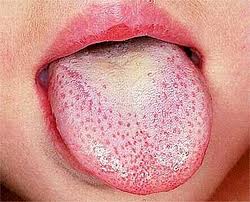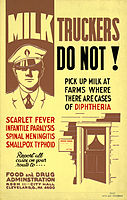
Scarlet fever
Scarlet fever, also known as scarlatina, is an infectious disease caused by Streptococcus pyogenes, a Group A streptococcus (GAS).[3] It most commonly affects children between five and 15 years of age.[1] The signs and symptoms include a sore throat, fever, headache, swollen lymph nodes, and a characteristic rash.[1] The face is flushed and the rash is red and blanching.[5] It typically feels like sandpaper and the tongue may be red and bumpy.[1] The rash occurs as a result of capillary damage by exotoxins produced by S.pyogenes.[6] On darker-pigmented skin the rash may be hard to discern.[7]
For other uses, see Scarlet fever (disambiguation).Scarlet fever
Sore throat, fever, headaches, swollen lymph nodes in the neck, characteristic rash[1]
5–15 years old[1]
Handwashing, not sharing personal items, staying away from sick people[1]
Typically good[1]
Scarlet fever develops in a small number of people who have strep throat or streptococcal skin infections.[1] The bacteria are usually spread by people coughing or sneezing.[1] It can also be spread when a person touches an object that has the bacteria on it and then touches their mouth or nose.[1] The diagnosis is typically confirmed by culturing swabs of the throat.[1]
There is no vaccine for scarlet fever.[1] Prevention is by frequent handwashing, not sharing personal items, and staying away from other people when sick.[1] The disease is treatable with antibiotics, which reduce symptoms and spread, and prevent most complications.[1] Outcomes with scarlet fever are typically good if treated.[1] Long-term complications as a result of scarlet fever include kidney disease, rheumatic fever, and arthritis.[1]
In the early 20th century it was a leading cause of death in children, but even before the Second World War and the introduction of antibiotics, its severity was already declining, perhaps due to better living conditions, the introduction of better control measures, or a decline in the virulence of the bacteria.[8][9] In recent years, there have been signs of antibiotic resistance; there was an outbreak in Hong Kong in 2011 and in the UK in 2014, and occurrence of the disease rose by 68% in the UK between 2014 and 2018. Research published in October 2020 showed that infection of the bacterium by three viruses has led to more virulent strains of the bacterium.[10]
Cause[edit]
Strep throat spreads by close contact among people, via respiratory droplets (for example, saliva or nasal discharge).[21] A person in close contact with another person infected with group A streptococcal pharyngitis has a 35% chance of becoming infected.[22] One in ten children who are infected with group A streptococcal pharyngitis will develop scarlet fever.[16]
Prevention[edit]
One method is long-term use of antibiotics to prevent future group A streptococcal infections. This method is only indicated for people who have had complications like recurrent attacks of acute rheumatic fever or rheumatic heart disease. Antibiotics are limited in their ability to prevent these infections since there are a variety of subtypes of group A streptococci that can cause the infection.[21]
Although there are currently no vaccines available, the vaccine approach has a greater likelihood of effectively preventing group A streptococcal infections in the future because vaccine formulations can target multiple subtypes of the bacteria.[21] A vaccine developed by George and Gladys Dick in 1924 was discontinued due to poor efficacy and the introduction of antibiotics. Difficulties in vaccine development include the considerable strain variety of group A streptococci present in the environment and the amount of time and number of people needed for appropriate trials for safety and efficacy of any potential vaccine.[39] There have been several attempts to create a vaccine in the past few decades. These vaccines, which are still in the development phase, expose the person to proteins present on the surface of the group A streptococci to activate an immune response that will prepare the person to fight and prevent future infections.[40]
There used to be a diphtheria scarlet fever vaccine.[41] It was, however, found not to be effective.[42] This product was discontinued by the end of World War II.
Epidemiology[edit]
Scarlet fever occurs equally in both males and females.[16] Children are most commonly infected, typically between 5–15 years old. Although streptococcal infections can happen at any time of year, infection rates peak in the winter and spring months, typically in colder climates.[21]
The morbidity and mortality of scarlet fever has declined since the 18th and 19th centuries when there were epidemics of this disease.[46] Around 1900 the mortality rate in multiple places reached 25%.[47] The improvement in prognosis can be attributed to the use of penicillin in the treatment of this disease.[13] The frequency of scarlet fever cases has also been declining over the past century.
There have been several reported outbreaks of the disease in various countries in the past decade.[48] The reason for these increases remains unclear in the medical community. Between 2013 and 2016 population rates of scarlet fever in England increased from 8.2 to 33.2 per 100,000 and hospital admissions for scarlet fever increased by 97%.[49] Further increases in the reporting of scarlet fever cases have been noted in England during the 2021–2022 season (September to September) and so far also in the season 2022–2023.[50] The World Health Organization has reported an increase in scarlet fever (and iGAS – invasive GAS cases) in England, and other European countries during this time. Increases have been reported in France and Ireland.[51] In the US, cases of scarlet fever are not reported, but as of December 2022, the CDC was looking at a possible increase in the numbers of invasive GAS infections reported in children.[52] In late December 2022, the CDC's Health Alert Network issued an advisory on the reported increases in invasive GAS infections.[53]


